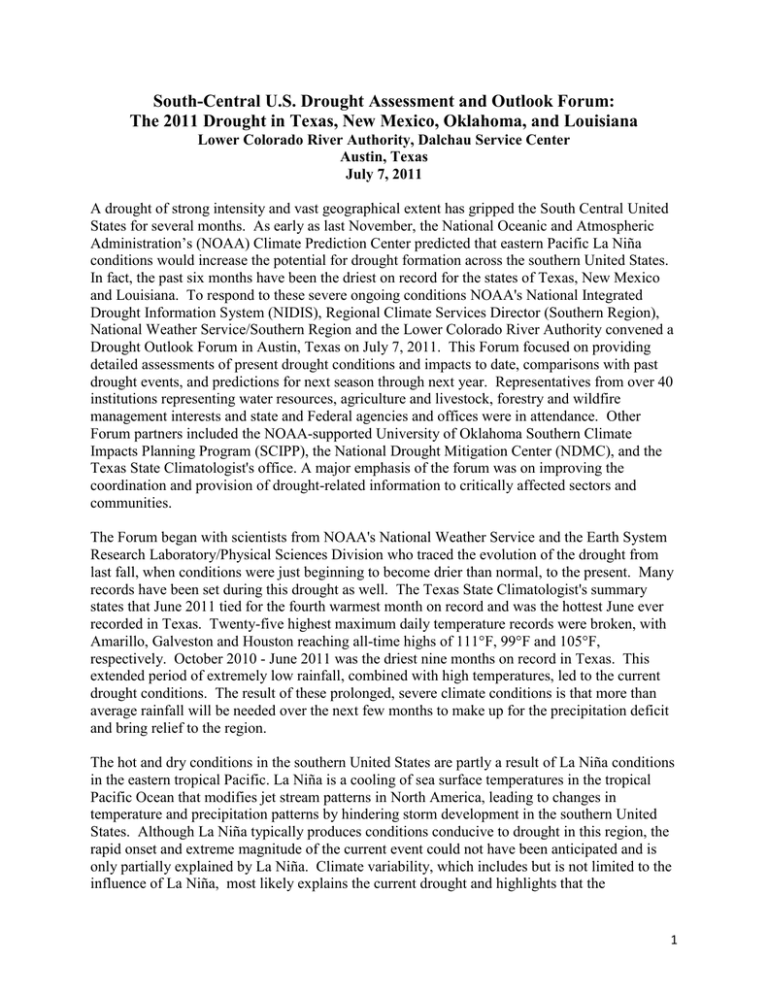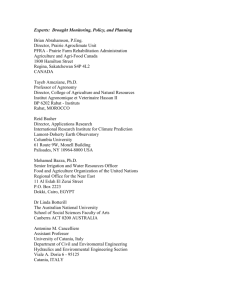South-Central U.S. Drought Assessment and Outlook Forum:
advertisement

South-Central U.S. Drought Assessment and Outlook Forum: The 2011 Drought in Texas, New Mexico, Oklahoma, and Louisiana Lower Colorado River Authority, Dalchau Service Center Austin, Texas July 7, 2011 A drought of strong intensity and vast geographical extent has gripped the South Central United States for several months. As early as last November, the National Oceanic and Atmospheric Administration’s (NOAA) Climate Prediction Center predicted that eastern Pacific La Niña conditions would increase the potential for drought formation across the southern United States. In fact, the past six months have been the driest on record for the states of Texas, New Mexico and Louisiana. To respond to these severe ongoing conditions NOAA's National Integrated Drought Information System (NIDIS), Regional Climate Services Director (Southern Region), National Weather Service/Southern Region and the Lower Colorado River Authority convened a Drought Outlook Forum in Austin, Texas on July 7, 2011. This Forum focused on providing detailed assessments of present drought conditions and impacts to date, comparisons with past drought events, and predictions for next season through next year. Representatives from over 40 institutions representing water resources, agriculture and livestock, forestry and wildfire management interests and state and Federal agencies and offices were in attendance. Other Forum partners included the NOAA-supported University of Oklahoma Southern Climate Impacts Planning Program (SCIPP), the National Drought Mitigation Center (NDMC), and the Texas State Climatologist's office. A major emphasis of the forum was on improving the coordination and provision of drought-related information to critically affected sectors and communities. The Forum began with scientists from NOAA's National Weather Service and the Earth System Research Laboratory/Physical Sciences Division who traced the evolution of the drought from last fall, when conditions were just beginning to become drier than normal, to the present. Many records have been set during this drought as well. The Texas State Climatologist's summary states that June 2011 tied for the fourth warmest month on record and was the hottest June ever recorded in Texas. Twenty-five highest maximum daily temperature records were broken, with Amarillo, Galveston and Houston reaching all-time highs of 111°F, 99°F and 105°F, respectively. October 2010 - June 2011 was the driest nine months on record in Texas. This extended period of extremely low rainfall, combined with high temperatures, led to the current drought conditions. The result of these prolonged, severe climate conditions is that more than average rainfall will be needed over the next few months to make up for the precipitation deficit and bring relief to the region. The hot and dry conditions in the southern United States are partly a result of La Niña conditions in the eastern tropical Pacific. La Niña is a cooling of sea surface temperatures in the tropical Pacific Ocean that modifies jet stream patterns in North America, leading to changes in temperature and precipitation patterns by hindering storm development in the southern United States. Although La Niña typically produces conditions conducive to drought in this region, the rapid onset and extreme magnitude of the current event could not have been anticipated and is only partially explained by La Niña. Climate variability, which includes but is not limited to the influence of La Niña, most likely explains the current drought and highlights that the 1 observational record to date does not represent the full assortment of drought scenarios that are possible for this region. NOAA's temperature and precipitation outlooks do not indicate significant relief for the region in the coming months; the outlooks predict a less than 5% chance that the rain needed to bring relief to central and eastern Texas will occur (with the possible exception of tropical storms making landfall). In addition, while La Niña conditions in the Pacific have abated (i.e., sea surface temperatures are now closer to normal), there is a chance that La Niña conditions in the Pacific will re-emerge later this summer or early fall, reinforcing dry conditions in the region. Discussions of available drought monitoring tools, information products and regional sources of authoritative drought information were facilitated by NIDIS and NDMC. In the afternoon of the Forum, three different groups of local experts shared their experiences in dealing with the drought. Representatives from Plains Grains, Texas Water Development Board, Texas Forest Service, Texas Parks and Wildlife Department and the Lower Colorado River Authority spoke about impacts to their sectors, many of which have been very costly. For example, since October 1, 2010 over 3.2 million acres have burned in Texas and Texas AgriLife Extension Service (Texas A&M System) estimates that drought losses have reached at least $1.2 billion. Many in the cattle industry have had to thin their herds and it will take years for ranchers to recover their losses. A panel of reporters from the Associated Press, Austin-American Statesmen, Texas Tribune and KXAN-TV Austin (NBC) discussed coverage of drought in the news and ways in which professionals in the field of drought monitoring and research can help enhance the media's drought reporting. General suggestions from the reporters for drought professionals included (1) clearly relating current conditions to historical conditions, (2) creating simple graphics summarizing the current situation, (3) being proactive with outreach to local reporters, and (4) more timely communications from water utilities regarding upcoming water restrictions. A press conference was also held during the day where reporters were provided with a summary of the Outlook and were given a chance to have a dialogue with the Outlook experts. The last panel of the day presented methods and challenges involved in state drought planning and response. The panel included drought experts from the states of Texas, Oklahoma, New Mexico and the National Drought Mitigation Center. One general recommendation from state drought planners was the need to more frequently assess and update the states' drought plans. Improving drought-related triggers and indicators for planning responses is critical. It was noted that if implementation of established triggers does not occur the state drought plan will become less effective. Another major issue is to enhance the ongoing interactions between the research community and decision makers. Communication is key, and all states represented on the panel have established means to communicate about drought monthly or more often as conditions warrant. The meeting wrapped up with a discussion of ways to improve the coordination and delivery of drought information between the information providers, in particular NIDIS, and the user community. Most agreed there is a wealth of hydrometeorological information available on the internet, but guidance on product interpretation, especially for understanding the drivers and 2 drought forecasts as well as systematic assessments of impacts are needed. The NIDIS drought portal (www.drought.gov), the National Weather Service (www.weather.gov) and U.S. Geological Survey (waterwatch.usgs.gov/new/) web sites were mentioned as helpful. It was noted that developing and posting more products and narratives understandable to the lay-person would be valuable. State extension agents were also identified as providers of useful local data regarding agricultural impacts and these should be represented on the information websites. Some Forum attendees requested help obtaining data at the local or basin scale and guidance in preparing local data for analysis or presentation to the public. Additional discussions identified opportunities and practical means to improve on delivery of information. All agreed that the Forum had provided a very positive step in that direction. There was further agreement among the participants that follow-up activities should include working with NIDIS to conduct an assessment of the impacts of this drought and to develop a best practices document for improving coordination among federal, state, and local agencies, and for improving how information is delivered for proactive decision making in the region. 3






